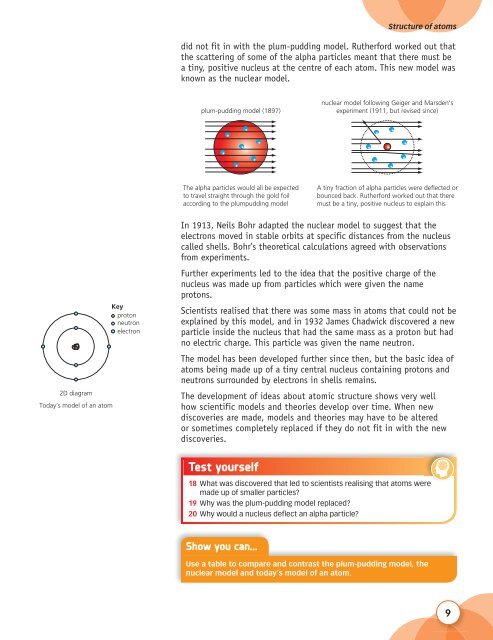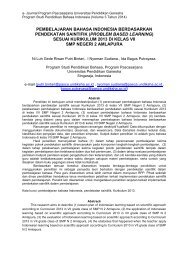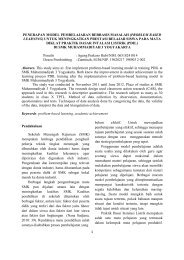You also want an ePaper? Increase the reach of your titles
YUMPU automatically turns print PDFs into web optimized ePapers that Google loves.
Structure of atoms<br />
did not fit in with the plum-pudding model. Rutherford worked out that<br />
the scattering of some of the alpha particles meant that there must be<br />
a tiny, positive nucleus at the centre of each atom. This new model was<br />
known as the nuclear model.<br />
plum-pudding model (1897)<br />
nuclear model following Geiger and Marsden’s<br />
experiment (1911, but revised since)<br />
The alpha particles would all be expected<br />
to travel straight through the gold foil<br />
according to the plumpudding model<br />
A tiny fraction of alpha particles were deflected or<br />
bounced back. Rutherford worked out that there<br />
must be a tiny, positive nucleus to explain this<br />
2D diagram<br />
Today’s model of an atom<br />
proton<br />
Key<br />
neutron<br />
electron<br />
In 1913, Neils Bohr adapted the nuclear model to suggest that the<br />
electrons moved in stable orbits at specific distances from the nucleus<br />
called shells. Bohr’s theoretical calculations agreed with observations<br />
from experiments.<br />
Further experiments led to the idea that the positive charge of the<br />
nucleus was made up from particles which were given the name<br />
protons.<br />
Scientists realised that there was some mass in atoms that could not be<br />
explained by this model, and in 1932 James Chadwick discovered a new<br />
particle inside the nucleus that had the same mass as a proton but had<br />
no electric charge. This particle was given the name neutron.<br />
The model has been developed further since then, but the basic idea of<br />
atoms being made up of a tiny central nucleus containing protons and<br />
neutrons surrounded by electrons in shells remains.<br />
The development of ideas about atomic structure shows very well<br />
how scientific models and theories develop over time. When new<br />
discoveries are made, models and theories may have to be altered<br />
or sometimes completely replaced if they do not fit in with the new<br />
discoveries.<br />
Test yourself<br />
18 What was discovered that led to scientists realising that atoms were<br />
made up of smaller particles?<br />
19 Why was the plum-pudding model replaced?<br />
20 Why would a nucleus deflect an alpha particle?<br />
Show you can...<br />
Use a table to compare and contrast the plum-pudding model, the<br />
nuclear model and today’s model of an atom.<br />
9





